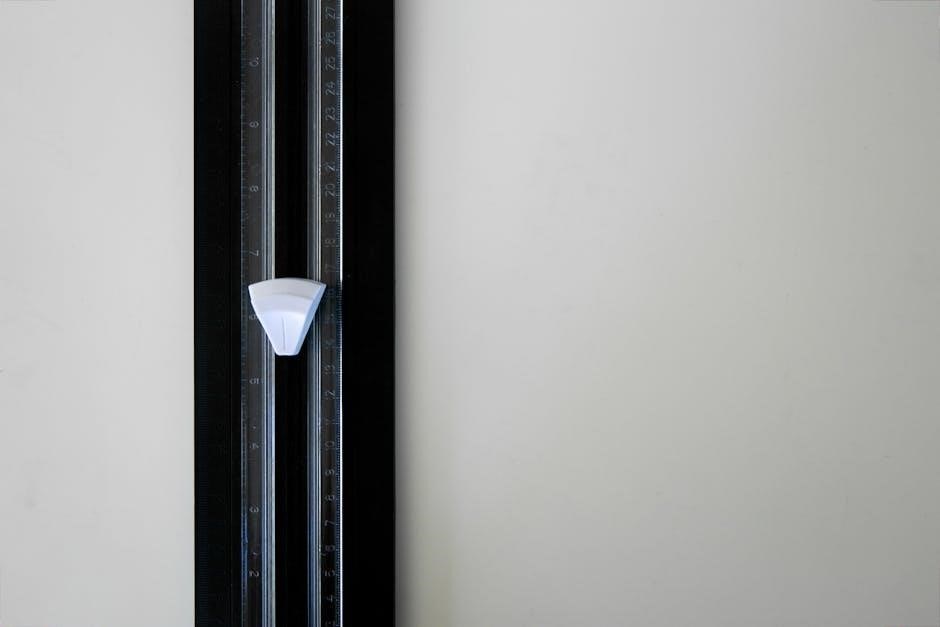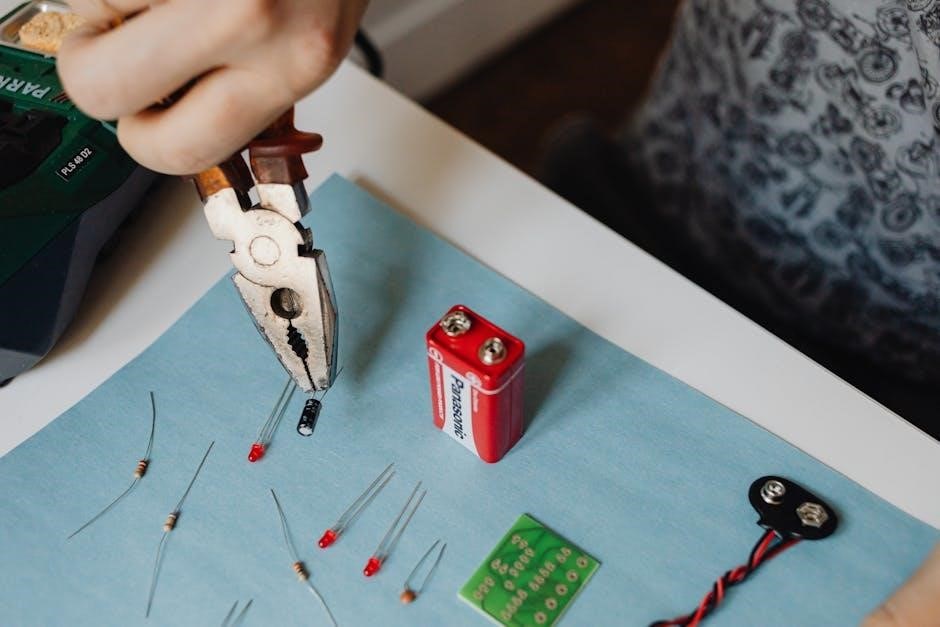This section introduces the Ryobi String Trimmer Parts Manual, providing a comprehensive guide to understanding and maintaining your trimmer․ It includes detailed parts identification, repair instructions, and safety tips to ensure optimal performance and longevity of your equipment․
1․1 Overview of Ryobi String Trimmers
Ryobi string trimmers are versatile lawn care tools designed for efficiency and ease of use․ Known for their durability and ergonomic design, these trimmers cater to both homeowners and professionals․ Available in gas-powered and electric models, they offer flexibility for various yard sizes and trimming needs․ Ryobi trimmers feature advanced components like adjustable handles and robust cutting heads, ensuring precise trimming and edging․ With a wide range of compatible accessories, users can customize their tools for specific tasks․ Ryobi’s commitment to innovation and affordability makes their string trimmers a popular choice for maintaining pristine outdoor spaces․ This overview highlights key features and benefits․
1․2 Importance of Understanding the Parts Manual
Understanding the Ryobi String Trimmer Parts Manual is essential for proper maintenance, troubleshooting, and repair․ It provides detailed diagrams, part numbers, and descriptions, enabling users to identify and replace worn or damaged components․ The manual serves as a comprehensive guide for diagnosing issues, such as faulty engines or feeding systems, and offers step-by-step repair instructions․ By familiarizing yourself with the manual, you can ensure safety, optimize performance, and extend the lifespan of your trimmer․ It also helps in ordering genuine Ryobi parts and performing routine upkeep, making it an invaluable resource for both novice and experienced users․

Key Components of Ryobi String Trimmers
Ryobi String Trimmers feature essential components like engines, cutting heads, shafts, handles, and safety guards․ These parts work together to ensure efficient trimming and durability for yard maintenance tasks․
2․1 Engine and Motor Components
Ryobi string trimmers are equipped with powerful engines and motors designed for reliable performance․ Gas-powered models feature 25cc to 30cc engines, while electric versions use robust motors․ Key components include the carburetor, spark plug, and air filter, ensuring proper fuel and air mixture for combustion․ Electric motors are built for durability and high torque․ Regular maintenance, such as cleaning the air filter and inspecting the spark plug, is essential for optimal engine performance․ These components work together to deliver consistent power, enabling efficient cutting and trimming of yard vegetation․ Proper care extends the lifespan of these critical parts, ensuring your trimmer runs smoothly season after season․
2․2 Cutting Head and String Feeding System
The cutting head and string feeding system are essential for the Ryobi string trimmer’s functionality․ The cutting head houses the trimmer line, which rotates to cut vegetation․ Most models feature a bump feed mechanism, where tapping the head on the ground releases more string․ Some trimmers also offer automatic line advancement for convenience․ Proper installation and adjustment of the cutting head ensure even cutting performance․ Regular inspection and replacement of worn or damaged lines are crucial for maintaining efficiency․ The manual provides detailed diagrams and instructions for servicing these components, ensuring optimal trimming results and extending the lifespan of the trimmer․
2․3 Shaft and Handle Assembly
The shaft and handle assembly are critical components of the Ryobi string trimmer, providing structural support and user control․ The shaft is typically made of durable materials like aluminum or steel, ensuring flexibility and strength․ Many models feature a split shaft design for easy storage and transport․ The handle is ergonomically designed for comfort, often with adjustable height settings to suit different users․ Some trimmers include anti-vibration technology in the handle to reduce fatigue during extended use․ The assembly also includes couplers or connectors that link the engine to the cutting head, ensuring smooth power transfer․ Proper maintenance of these parts is essential for reliable performance․
2․4 Safety Features and Guards
The Ryobi string trimmer is equipped with essential safety features and guards to protect users during operation․ A protective cutting guard is installed near the trimming head to deflect debris, preventing injuries from flying particles․ Additionally, some models include a spark arrestor to reduce fire hazards in dry conditions․ The trimmer’s design incorporates ergonomic handles with grip enhancements to prevent slipping․ Users are advised to wear protective gear, such as gloves and eye protection, as outlined in the manual․ Regular inspection of these safety components is crucial to ensure they function properly․ These features collectively enhance user safety and minimize risks associated with trimming operations․

Parts Identification and Diagrams
This section provides a comprehensive guide to identifying and understanding the components of your Ryobi string trimmer․ Detailed diagrams and part numbers help users locate and replace parts efficiently, ensuring accurate repairs and maintenance․
3․1 Decoding the Parts List
Decoding the parts list is essential for identifying and ordering replacement components for your Ryobi string trimmer․ Each part is assigned a unique number and description, such as “661848001” for a screw or “638845006” for a line cut-off blade․ The list is organized alphabetically or by component category, making it easier to locate specific items․ Understanding the numbering system helps users cross-reference parts with diagrams and manuals․ Additionally, the list often includes quantities and descriptions, ensuring accurate identification․ This section guides users in interpreting the codes and descriptions, enabling them to efficiently find and replace parts, ensuring proper functionality and maintenance of their trimmer․
3․2 Interpreting the Diagrams
Interpreting the diagrams in the Ryobi string trimmer parts manual is crucial for understanding the assembly and location of each component․ These visual guides use symbols, numbers, and labels to represent parts, making it easier to identify their positions and relationships․ The diagrams often include a key or legend to decode symbols, ensuring clarity․ By referencing these visuals, users can pinpoint specific parts, such as the cutting head or shaft, and see how they connect․ This section helps users align the diagrams with the parts list, facilitating accurate identification and ordering of components․ Mastering this skill enhances maintenance and repair efficiency, ensuring your trimmer operates at its best․
3․3 Key Part Numbers and Descriptions
This section provides a detailed list of key part numbers and their corresponding descriptions for the Ryobi string trimmer․ Each component, such as screws, blades, and motor parts, is assigned a unique identifier to simplify identification and ordering․ For example, part number 661848001 refers to a specific screw used in the trimmer’s assembly․ By cross-referencing these numbers with the diagrams, users can locate and replace parts efficiently․ This section is essential for ensuring accuracy when purchasing or replacing components, helping you maintain your trimmer effectively and keep it in optimal working condition․ Accurate part identification is crucial for successful repairs and maintenance․

Maintenance and Upkeep
Regular cleaning of the trimmer head, lubrication of moving parts, and proper storage are essential for maintaining your Ryobi string trimmer’s performance and longevity․
4․1 Regular Cleaning and Lubrication
Regular cleaning and lubrication are crucial for maintaining your Ryobi string trimmer’s performance․ Clean the cutting head and surrounding areas after each use to prevent debris buildup․ Lubricate moving parts, such as the shaft and gears, to reduce friction and wear․ Use a soft cloth to wipe down the trimmer and remove dirt or grass clippings․ Check for worn or damaged components during cleaning and replace them as needed․ Proper lubrication ensures smooth operation and extends the lifespan of your trimmer․ Always refer to the manual for specific lubrication points and recommended products․
- Clean the trimmer head after each use․
- Lubricate moving parts to reduce friction․
- Inspect for wear or damage during maintenance․
4․2 Replacing Wearable Parts
Replacing wearable parts is essential to maintain your Ryobi string trimmer’s efficiency․ Common wearable parts include the cutting line, blades, and bump head․ Regularly inspect these components for wear or damage․ If the cutting line is frayed or broken, replace it with the correct gauge and length specified in the manual․ For blades, ensure they are sharp and free of damage․ The bump head may need replacement if it shows excessive wear․ Refer to the parts diagram for accurate identification and replacement procedures․ Always use genuine Ryobi parts to ensure compatibility and performance․ Proper replacement extends the trimmer’s lifespan and maintains cutting effectiveness․
- Inspect wearable parts regularly for damage․
- Replace the cutting line with the correct specifications․
- Use genuine Ryobi parts for optimal performance․
4․3 Storing the Trimmer Properly
Proper storage of your Ryobi string trimmer is crucial for maintaining its performance and longevity․ Store it in a dry, cool place away from direct sunlight and moisture․ For gas-powered trimmers, drain the fuel tank or use a fuel stabilizer to prevent degradation․ Clean the trimmer thoroughly, removing dirt and debris to avoid rust or corrosion․ Lubricate moving parts as recommended in the manual to maintain flexibility and prevent stiffness․ For electric trimmers, disconnect the battery to avoid discharge․ Hang the trimmer securely to save space and protect against damage․ Always follow the manufacturer’s guidelines for storage to ensure your trimmer remains in optimal condition for future use․
- Store in a dry, cool environment․
- Drain fuel or use a stabilizer for gas models․
- Disconnect batteries for electric models․
- Clean and lubricate before storage․

Troubleshooting Common Issues
Troubleshooting common issues with your Ryobi string trimmer involves identifying problems like engine failure, faulty string feeding, or excessive vibration․ Refer to the manual for diagnostic steps and solutions to restore functionality quickly․
5․1 Engine Not Starting
If your Ryobi string trimmer’s engine fails to start, check the fuel level and ensure it’s the correct type․ A faulty spark plug or blocked air filter can also prevent ignition․ Inspect the choke for proper function and clean or replace the air filter as needed․ Additionally, check for blockages in the muffler or fuel line․ Verify the ignition coil is functioning correctly and ensure the cutting head is properly assembled․ Refer to your manual for specific diagnostic steps and solutions to address the issue effectively․ Regular maintenance, such as cleaning the air filter and spark plug, can help prevent engine startup problems․
5․2 String Not Feeding Properly
If the string on your Ryobi trimmer isn’t feeding correctly, check if the cutting head is properly assembled and aligned․ Ensure the string length doesn’t exceed the recommended size, as this can prevent proper feeding․ Inspect for tangles or knots in the line, which may require rewinding or replacing the spool․ Debris or dirt in the cutting head can also disrupt feeding; clean it thoroughly․ Verify that the line is installed according to the manual and that the correct type of string is used․ If issues persist, consult the parts manual for specific troubleshooting steps or consider replacing the feeding mechanism․
5․3 Vibration or Noise
Excessive vibration or unusual noise in your Ryobi string trimmer can indicate improper assembly, imbalance, or worn parts․ Check the cutting head for debris and ensure the string is correctly installed․ Verify that all screws and bolts are tightened properly․ If the noise persists, inspect the shaft and handle for damage or misalignment․ Lubricate moving parts and ensure the engine is free from obstructions․ For severe issues, consult the parts manual to identify and replace faulty components, such as bearings or the fan, to restore smooth operation․

Repair and Replacement Guide
This guide provides step-by-step instructions for repairing and replacing parts of your Ryobi string trimmer, including tools needed and referencing detailed diagrams for accuracy․
6․1 Replacing the Cutting Line
Replacing the cutting line on your Ryobi string trimmer is a straightforward process that ensures optimal performance․ Begin by turning off and unplugging the trimmer for safety․ Remove the spool by pressing the release button or twisting the spool cap, depending on your model․ Cut the new line to the recommended length, typically 10-15 feet, and thread it through the spool, leaving equal lengths on both sides․ Reattach the spool and wind the line tightly․ Finally, trim excess line with scissors and test the trimmer․ Always use the correct line size for your model to maintain efficiency and avoid damage․
6․2 Fixing a Damaged Trimmer Head
A damaged trimmer head can hinder your Ryobi string trimmer’s performance․ Start by disconnecting the spark plug and ensuring the device is cool․ Remove the head by loosening the bolts or clips, depending on your model․ Inspect for worn or broken parts like the spool, gears, or housing․ Replace any damaged components with genuine Ryobi parts for optimal functionality․ Reassemble the head, ensuring all parts are securely tightened․ Finally, test the trimmer to ensure proper operation․ Regular maintenance and prompt repairs can extend the life of your trimmer and maintain its cutting efficiency․ Always refer to your manual for specific instructions․
6․3 Replacing the Shaft or Handle
Replacing the shaft or handle on your Ryobi string trimmer is essential for maintaining its functionality․ Start by disconnecting the spark plug for safety․ Remove any screws or bolts securing the shaft or handle․ Gently pull out the shaft or replace the handle with a new one, ensuring it is tightly secured․ Reassemble the parts and test the trimmer to ensure proper operation․ Always refer to your Ryobi parts manual for specific instructions and use genuine Ryobi parts for the best results․ This process will help restore your trimmer’s performance and extend its lifespan․

Safety Precautions
Always wear protective gear, including gloves and eyewear, when operating your Ryobi string trimmer․ Ensure the area is clear of debris and follow all safety guidelines in the manual․
7․1 General Safety Guidelines
Before using your Ryobi string trimmer, always read and follow the safety guidelines in the manual․ Wear protective gear, including gloves and eyewear, to prevent injuries from debris․ Ensure the area is clear of obstacles and bystanders․ Regularly inspect the trimmer for damaged or worn parts, and replace them promptly․ Avoid operating the trimmer in hazardous conditions, such as wet environments or near flammable materials․ Keep children and pets away while the trimmer is in use․ Store the trimmer properly after each use, ensuring it is cool and out of reach of unauthorized users․ Follow these guidelines to ensure safe and effective operation․
7․2 Protective Gear and Clothing
Wearing appropriate protective gear and clothing is essential when operating a Ryobi string trimmer․ Always wear safety glasses or goggles to protect your eyes from flying debris․ Use long pants or sturdy work pants to guard against cuts and abrasions․ Wear gloves to improve grip and prevent blisters․ Closed-toe shoes or boots are recommended to protect your feet from injury․ Avoid loose clothing that could get caught in the trimmer․ If needed, wear a face mask to shield against dust and debris․ Proper attire ensures a safer and more comfortable trimming experience while minimizing potential risks․
7․3 Operating in Hazardous Conditions
When operating a Ryobi string trimmer in hazardous conditions, exercise extreme caution to ensure safety․ Avoid using the trimmer in wet or damp environments, as this increases the risk of electrical shock․ Never operate near open flames or sparks, especially when trimming dry vegetation․ Steep slopes or uneven terrain can cause loss of balance, so use extra care and consider alternative methods․ Keep the area clear of debris, children, and pets․ If operating in dense or overgrown areas, wear protective gear and proceed slowly․ Always maintain a firm grip and stay alert to avoid accidents in challenging environments․

Accessories and Upgrades
Explore Ryobi’s range of compatible accessories to enhance functionality․ Upgrading components can improve performance and durability, ensuring your trimmer remains efficient and reliable over time․
8․1 Compatible Accessories
Ryobi offers a variety of compatible accessories designed to enhance the functionality of your string trimmer․ These include high-quality cutting lines, replacement heads, and ergonomic handles․ Upgrade your trimmer with advanced features like adjustable handles or brush cutter blades for tougher tasks․ Battery upgrades and chargers are also available for cordless models, ensuring longer runtime and faster charging․ Additionally, protective gear like eyewear and gloves can be found to complement your trimming experience․ Always ensure compatibility by referencing your Ryobi String Trimmer Parts Manual or checking the manufacturer’s website․ These accessories are crafted to maintain performance and durability, keeping your trimmer in optimal condition․
8․2 Upgrading the Trimmer
Upgrading your Ryobi string trimmer is a straightforward process that can significantly enhance its performance and versatility․ Consider upgrading the cutting head to a metal blade for tougher vegetation or switching to a high-capacity battery for extended use․ Ergonomic handle attachments can improve comfort during long sessions, while advanced line feeding systems reduce downtime․ For cordless models, upgrading to a faster charger ensures minimal interruptions․ Always consult the Ryobi String Trimmer Parts Manual to ensure compatibility and follow installation guidelines․ These upgrades not only extend the life of your trimmer but also tailor it to your specific landscaping needs, making it a more efficient and reliable tool for yard maintenance․
8․3 Using Aftermarket Parts
Using aftermarket parts for your Ryobi string trimmer can be a cost-effective way to maintain or upgrade your tool․ However, it’s crucial to ensure these parts are compatible with your specific model to avoid performance issues or damage․ Always check the Ryobi String Trimmer Parts Manual for part numbers and specifications before purchasing․ Reputable brands offer high-quality aftermarket components, such as cutting lines, blades, and engine parts, designed to meet or exceed original standards․ Be cautious of low-quality alternatives, as they may compromise durability or functionality․ Proper installation and maintenance of aftermarket parts are essential to ensure optimal performance and extend the life of your trimmer;

Environmental Considerations
This section covers eco-friendly trimming practices, proper disposal of parts, and energy-efficient operation to minimize environmental impact while maintaining your Ryobi string trimmer․
9․1 Eco-Friendly Trimming Practices
Eco-friendly trimming practices involve using energy-efficient methods to reduce environmental impact․ Opt for rechargeable batteries, proper string sizes, and regular maintenance to minimize energy consumption․ Dispose of worn parts responsibly, ensuring hazardous materials are handled correctly․ Using biodegradable trimmer line and avoiding over-trimming preserves vegetation health․ Maintain cutting heights to protect plant roots and biodiversity․ Always follow local regulations for trimming near water sources or wildlife areas․ Proper storage and recycling of old parts further support sustainability․ By adopting these practices, you contribute to a greener environment while keeping your Ryobi trimmer in optimal condition․
9․2 Proper Disposal of Parts
Proper disposal of Ryobi string trimmer parts is essential for environmental sustainability․ Always check local regulations for hazardous waste disposal, as some components like batteries or oil may require special handling․ Separate recyclable materials, such as metal or plastic parts, and take them to designated recycling centers․ Avoid disposing of large or complex parts in regular trash; For electronic components, consider using e-waste recycling programs․ Properly packaging and labeling waste ensures safe handling․ By responsibly disposing of parts, you help reduce environmental impact and contribute to a greener future․ Refer to local guidelines for detailed instructions on disposal procedures․

Downloading and Using the Manual
Access the Ryobi String Trimmer Parts Manual online through Ryobi’s official website or platforms like ManualsLib․ The manual is free to download and includes detailed diagrams, part numbers, and repair instructions to help you maintain and fix your trimmer effectively․
10․1 Finding the Correct Manual Online
Locating the correct Ryobi String Trimmer Parts Manual is straightforward․ Visit Ryobi’s official website or platforms like ManualsLib, which host a wide range of user manuals․ Use the search bar to enter your specific trimmer model number, such as RY40210 or RY40220, to find the exact manual․ Ensure the model number matches your device for accurate information․ Many manuals are available in PDF format, making them easy to download and print․ Additionally, websites like Sears PartsDirect offer detailed parts diagrams and manuals for specific Ryobi models․ Always verify the source to ensure authenticity and avoid incorrect or outdated versions․
10․2 Navigating the Manual
Navigating the Ryobi String Trimmer Parts Manual is designed to be user-friendly․ The manual typically starts with a table of contents, allowing quick access to specific sections like parts lists, troubleshooting, or maintenance guides․ Detailed diagrams and exploded views help identify components, while part numbers are cross-referenced for easy lookup․ Use the index to find specific topics or tools․ Many manuals include a troubleshooting section to diagnose common issues․ Always reference your model number to ensure accuracy; By familiarizing yourself with the manual’s structure, you can efficiently locate the information needed for repairs, parts replacement, or routine maintenance, ensuring your trimmer operates at peak performance․
10․3 Using the Manual for Repairs
The Ryobi String Trimmer Parts Manual is an essential tool for repairs, offering step-by-step instructions and detailed diagrams․ It provides part numbers, descriptions, and exploded views to help identify and replace damaged components․ Use the troubleshooting section to diagnose common issues like faulty engines or feeding systems․ Refer to the parts list to order replacement components accurately․ The manual also includes safety precautions to follow during repairs․ By following the guide, you can address problems efficiently, ensuring your trimmer functions properly․ Always cross-reference your model number with the manual to guarantee compatibility and accuracy during the repair process․
The Ryobi String Trimmer Parts Manual serves as a comprehensive guide for maintenance, troubleshooting, and repairs․ By following its instructions, users can ensure their trimmer performs optimally and lasts longer․
11․1 Summary of Key Points
This manual provides a detailed overview of the Ryobi String Trimmer, focusing on parts identification, maintenance, and troubleshooting․ It emphasizes regular cleaning, lubrication, and proper storage to extend the trimmer’s lifespan․ Key sections include decoding parts lists, interpreting diagrams, and understanding safety features․ Troubleshooting guides address common issues like engine startup problems and string feeding malfunctions․ The manual also highlights eco-friendly practices and proper disposal of worn parts․ By following the instructions, users can optimize their trimmer’s performance, reduce downtime, and ensure safe operation․ This comprehensive guide is essential for both DIY enthusiasts and professionals seeking to maintain their Ryobi equipment effectively․
11․2 Final Tips for Effective Use
For optimal performance, always refer to the Ryobi String Trimmer Parts Manual before making repairs or adjustments․ Regularly inspect and replace worn parts to prevent mechanical failures․ Use genuine Ryobi replacement components to ensure compatibility and reliability․ Keep the trimmer head clean and properly lubricated to maintain efficient cutting․ Store the trimmer in a dry, secure location to protect it from damage․ Follow safety guidelines to avoid accidents and ensure longevity․ By adhering to these tips, users can maximize their trimmer’s efficiency, reduce maintenance costs, and enjoy consistent results in their lawn care tasks․

